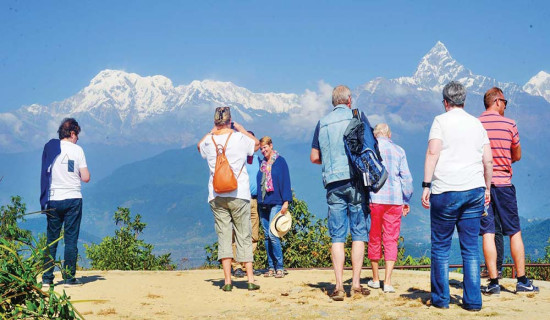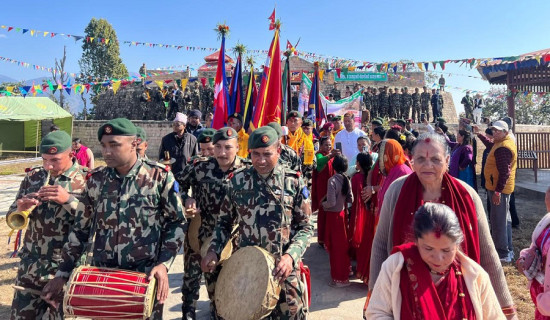- Thursday, 8 January 2026
Promoting Political Harmony Via Lullabies
A novel political tactic has surfaced in Nepal, one that reaches the hearts of the populace with the comforting sounds of lullabies. In this multicultural South Asian country, conversations on the relationship between politics, culture, and community have been triggered by this unorthodox method. This calming and rhythmic custom has developed into a nuanced yet effective means of communicating political opinions and promoting harmony. The soothing tunes of lullabies have become more than just a traditional part of Nepali society; they are now an effective means of promoting harmony and camaraderie within the political sphere.
In Nepal, lullabies—which are often connected to maternity care and strengthening family bonds—have become a powerful instrument for political activism and opposition. In a nation characterised by long-standing power conflicts and social upheavals, lullabies have become a symbol of resistance, community, and cultural preservation. The simple act of singing lullabies has evolved as a unifying factor, bringing people together across political divisions, despite the political intricacies that have characterised Nepal's past. The shared experience of calming their kids to these calming songs unites families from different backgrounds, fostering a bond that cuts beyond political differences.
Anthems of resistance
Once restricted to the house, the lullabies have become a symbol of quiet protest and unanimity in public places. Families congregate in public spaces like parks, squares, and community centres, fostering a peaceful atmosphere that cuts over political differences. The gentle tones of bedtime songs meld with the murmurs of political discourse, forming a distinctive symphony that subverts the conventional understanding of political participation. Nepal's multi-ethnic fabric is made up of a patchwork of languages, cultures, and customs. Singing lullabies in one's native tongue is a form of cultural protest against a prevailing political narrative that frequently marginalises minority voices.
Communities preserve their unique identities and fight against being absorbed into a unified national story by passing down ancestor songs from generation to generation. In Nepal, lullabies are used not just to preserve cultural legacy but also to raise political awareness among the general public. These tunes advocate for social justice, human rights, and democratic principles via subtly poetic lyrics and allegorical narrative. A grassroots instrument for increasing awareness and encouraging civic participation, lullabies emerge in a country that is battling structural injustices and political unrest. Throughout its turbulent political history, which has been characterised by revolutionary uprisings and civil unrest, lullabies have been woven into the fabric of resistance in Nepal.
These songs have functioned as anthems of resistance for everything from the Maoist insurgency to pro-democracy rallies, resonating through the streets as a collective voice of the downtrodden and disadvantaged. Lullabies become a unifying force, inspiring people to take up collective action and bring about social change, when poets include political views into their songs. But there are difficulties and disagreements associated with the politics of nursery rhymes in Nepal. Political groups run the danger of diluting the original significance of these cultural items and using them as propaganda weapons when they appropriate them for their own purposes. Furthermore, discussions on cultural appropriation and language hegemony highlight the difficulties of utilising lullabies as a political instrument. Both proponents and opponents of this movement have expressed interest in it. Singing lullabies, according to proponents, strengthens the relationship between family members and emphasises the value of that bond above political disagreements.
Critics, however, doubt the effectiveness of using a non-conventional method to handle complicated political matters. The administration has danced carefully in reaction to this occurrence. Authorities acknowledge that these meetings are calm, but they are nevertheless on the lookout for any possibility that these seemingly benign lullaby sessions may turn into more overt forms of opposition. The lullaby movement is becoming more and more of a representation of optimism and resiliency for a country that is figuring out the complex dance of politics. The lyrics, which frequently convey subdued themes of harmony and peace, reverberate long after birth, striking a chord in the minds of those who wish to live in harmony with one another.
Resilience
Nepal discovers a new avenue for political speech in the quiet tones of lullabies, one that goes beyond traditional means of communication. Only time will tell if it results in real political change or if it stays a heartfelt but symbolic gesture. However, the sound of lullabies persists in permeating Nepal's political narrative, serving as a soothing reminder that, underneath the din of competing ideas, there is a shared longing for a peaceful and unified future. Singing lullabies becomes a subtle representation of resilience and resistance in the complex terrain of Nepali politics, where identities are entwined with ideology. These timeless tunes represent the hopes, hardships, and aspirations of a country working towards social justice and political empowerment, beyond just their lyrical appeal. The echoes of lullabies resonate as Nepal forges ahead towards a more democratic and inclusive future, demonstrating the culture's ongoing influence on political debate and societal reform.
(The author is an advocate)
















